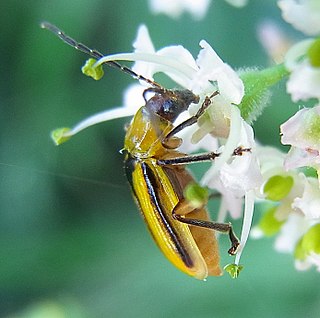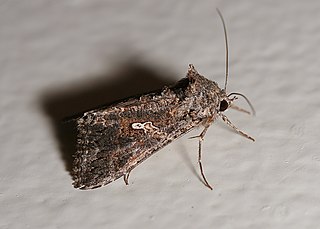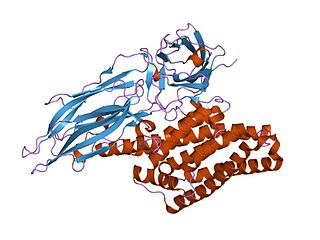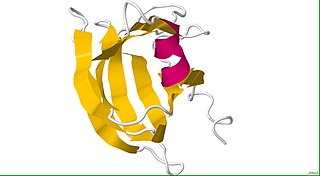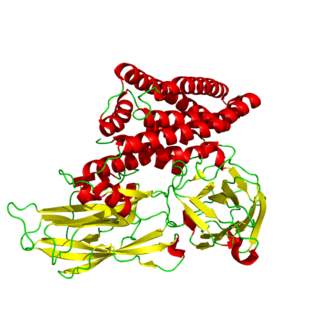| 13.6 kDa insecticidal crystal protein | |||||||
|---|---|---|---|---|---|---|---|
| Identifiers | |||||||
| Organism | |||||||
| Symbol | Cry34Ab1 | ||||||
| UniProt | Q939T0 | ||||||
| |||||||
| 43.8 kDa insecticidal crystal protein | |||||||
|---|---|---|---|---|---|---|---|
| Identifiers | |||||||
| Organism | |||||||
| Symbol | Cry35Ab1 | ||||||
| UniProt | Q939S9 | ||||||
| |||||||
Cry34Ab1 is one member of a binary Bacillus thuringiensis (Bt) crystal protein set isolated from Bt strain PS149B1. [1] The protein exists as a 14 kDa aegerolysin that, in presence of Cry35Ab1, exhibits insecticidal activity towards Western Corn Rootworm. [1] [2] The protein has been transformed into maize plants under the commercialized events 4114 (DP-ØØ4114-3) by Pioneer Hi-Bred and 59122 (DAS-59122-7) by Dow AgroSciences. These events have, in turn, been bred into multiple trait stacks in additional products.
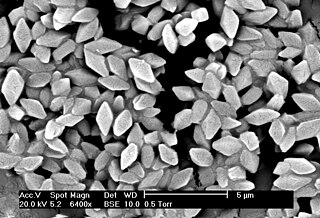
Bacillus thuringiensis is a Gram-positive, soil-dwelling bacterium, commonly used as a biological pesticide. B. thuringiensis also occurs naturally in the gut of caterpillars of various types of moths and butterflies, as well on leaf surfaces, aquatic environments, animal feces, insect-rich environments, and flour mills and grain-storage facilities. It has also been observed to parasitize other moths such as Cadra calidella—in laboratory experiments working with C. calidella, many of the moths were diseased due to this parasite.

In molecular biology, transformation is the genetic alteration of a cell resulting from the direct uptake and incorporation of exogenous genetic material from its surroundings through the cell membrane(s). For transformation to take place, the recipient bacteria must be in a state of competence, which might occur in nature as a time-limited response to environmental conditions such as starvation and cell density, and may also be induced in a laboratory.

Maize, also known as corn, is a cereal grain first domesticated by indigenous peoples in southern Mexico about 10,000 years ago. The leafy stalk of the plant produces pollen inflorescences and separate ovuliferous inflorescences called ears that yield kernels or seeds, which are fruits.
Cry34/35Ab1 binary toxins bind to the insect's brush border membrane vesicles (BBMVs) of cells in the epithelial lining of midgut, where they form pores; this leads to necrosis and, eventually, the insect's death. [3] The Cry35Ab1 (45 kDa) protein does not convey specificity in the absence of Cry34Ab1, indicating that the smaller 14 kDa Cry34Ab1 protein is critical for BBMV binding and recruitment of Cry35Ab1 to induce insecticidal effect. [2]
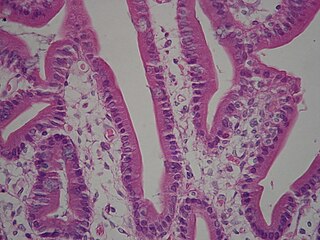
A brush border is the microvilli-covered surface of simple cuboidal epithelium and simple columnar epithelium cells found in certain locations of the body. Microvilli are approximately 100 nanometers in diameter and their length varies from approximately 100 to 2,000 nanometers in length. Because individual microvilli are so small and are tightly packed in the brush border, individual microvilli can only be resolved using electron microscopes; with a light microscope they can usually only be seen collectively as a fuzzy fringe at the surface of the epithelium. This fuzzy appearance gave rise to the term brush border, as early anatomists noted that this structure appeared very much like the bristles of a paintbrush.

Necrosis is a form of cell injury which results in the premature death of cells in living tissue by autolysis.
Cry34Ab1 is unrelated to Bt delta-endotoxins. It is an aegerolysin (Pfam PF06355) composed of two beta sheets in a beta-sandwich structure; the total protein is composed of 117 amino acid residues and contains a hydrophobic core. [4] Its family placement shows that interaction with cell membranes is consistent with its role in the binary Cry34Ab1/Cry35Ab1 toxin complex. [4] The partner toxin, Cry35Ab1, is a prototypical member of its own group (Pfam PF05431). Its structure is similar to that of aerolysin, Cry45Aa1, and Cry46Aa1. [4]

Pfam is a database of protein families that includes their annotations and multiple sequence alignments generated using hidden Markov models. The most recent version, Pfam 32.0, was released in September 2018 and contains 17,929 families.

In molecular biology, aerolysin is a cytolytic pore-forming toxin exported by Aeromonas hydrophila, a Gram-negative bacterium associated with diarrhoeal diseases and deep wound infections. The mature toxin binds to eukaryotic cells and aggregates to form holes leading to the destruction of the membrane permeability barrier and osmotic lysis. The structure of proaerolysin has been determined to 2.8A resolution and shows the protoxin to adopt a novel fold. Images of an aerolysin oligomer derived from electron microscopy have helped to construct a model of the protein in its heptameric conformation, and to outline a mechanism by which this assembly might insert into lipid bilayers to form ion channels.



